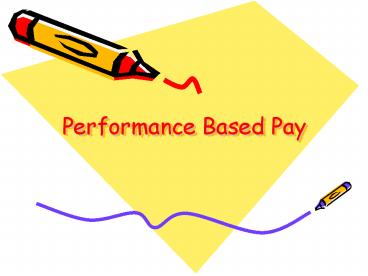Performance Based Pay PowerPoint PPT Presentation
1 / 48
Title: Performance Based Pay
1
Performance Based Pay
2
Todays class brought to you by China/Hong Kong
3
Real excitement of Compensation
- How do you create Performance base pay system
that works. Companies extoll their Performance
based pay system, yet none seems to be
universally strong.
4
Skill based pay
- Determine compensable competencies for type of
work. Tie to strategic issues. - Provide training opportunities to get increased
competencies! - Offer competency tests either selection or post
selection. Floor performance standards.
5
- Sauer Danfoss- base pay and then added pay for
skills.
6
Why not rely on external market only?
- Or Why is this important?
7
Strategic issues
- Relative importance of base pay vs performance
pay. - Company emphasizing innovation, customer service,
teams, internal labor markets etc.
8
Pay for perf
- Benchmark
9
Pay for performance
- Video
10
- Controversial
- Intrinsic vs extrinsic motivation
- Does extrinsic motivation always prevail?
- If so, then must people be paid to do everything?
When do they sacrifice self-interest for
organizational interest?
11
Pay is but one tool for performance management
- Strategic HR relies on Performance
management--which tools used. How to create an
organizational culture related to performance
management. - Do you wish to pay for performance?
- What are problems/advantages?
12
Medical Care
- McFarland Clinic
- Medical care is hot because of culture change.
- Doctors, lab, x-ray, receptionists.
- Pay for performance or other motivators?
- What type of climate are you building.
13
What type of culture is
- Most likely to link pay and performance.
- Least likely to link pay and performance (rely on
other motivators).
14
Other ways to link pay and individual performance
- Bonuses
- Commissions
- Stock options
15
How Incentives for teams?
- P-G fit
- PO fit
- Brainstorm in teams
- Consider types of incentives, group,
organizational individual.
16
Kerr Case
17
ISSUE
- Folly of Hoping for A but no extrinsic rewards.
- Folly of Hoping for A but rewarding for B.
- Outcome measures.
18
Summary
- What is pay used for?
- What influences the relative use in different
organizations. - If primarily motivation--how can it be used to
recruit and retain or visa-versa.
19
Goal
- Current trends towards flexibility
- Cost Issues (cost containment and cost benefit).
- Benefits management
20
Types of benefits
- Security (Income protection)
- Convenience (time/stress management).
21
Why are benefits important?
- From an employee perspective
- From an employer perspective
22
Employers
- Quality of life and the impact on productivity
(spillover of work and family). - Recruitment
- Retention
23
Trends towards Flexibility in electing benefits
- Cafeteria benefits. allocation may elect
variety of benefits given costs. ISU offers
health, disability, accidental death, life,
dental. - What do you need. Either pay for more coverage
or elect. Not really cost management issue--just
help retention and recruitment.
24
Towards Flexibility in Coverage
25
What is the basis for this?
26
Trends towards Increasing coverage
- Prepaid legal
- adoption benefits
- Hopefully more in benchmarking
27
Benchmark reports
28
Family Benefits Increasing
- Job as family benefits administrator
- More benefits
29
Change over time
30
Cost issues
- Do Benefits pay for themselves? Costs/benefits
ratio. How do you determine? - Increasing trend towards results
- Getting into the rankings
31
Reducing claims
32
Pay for themselves
- Why do companies offer preventative medicine--
smoke enders, weight watchers, free shots - What about Wellness programs
- Should Ford Keep up Volvos benefits?
33
Should you offer
- Fertility medical coverage and child care?
- Car pooling and disability insurance?
34
Should you
- For health insurance, verify not covered under
other insurers
35
Family Benefits
- Chubb estimates from exit interviews that 50
employees left for childcare reasons - It cost 97 of wages to replace non-exempt and
150 of wages to replace exempt. - 3 million dollars in replacement costs
36
(No Transcript)
37
(No Transcript)
38
(No Transcript)
39
offers
- Paid time off
- Child-care for snow days
- telecommuting
- Flexibility
40
In spite of popularity
- Few firms offer
- People strongly value Security benefits.
- New benefits excluding child care are modest cost.
41
Who offers
- Unions
- Larger employers
- Industry
- Corporate image
42
Benefits of Benefits
- Does it help?
43
Problems with Benefits
- Employee backlash especially family benefits.
- Not clear that benefits have much impact on
recruitment unless clearly one of the 100 best
places to work or equivalent in a region. Some
evidence for retention. Would the money best be
put elsewhere?
44
Will these go away in times of high unemployment
45
Eldercare, spouse care, parent care
46
Linking Benefits to Strategy/Labor Markets
- Retailer relies on students for seasonal sales.
Evidence is clear that sales is more than double
if return. How to increase retention through
benefits. - Vacation days could be example for retention of
employees.
47
Benefits Management
- Benefits communication
- Have it and want people to take advantage of
them. ISU has problems with wellness. - How to communicate? Just in time.
48
Summary
- Importance of benefits increasing.
- Portion of benefits as total compensation
increased over the past thirty years. - Purpose is critical and getting the most for your
dollar.

